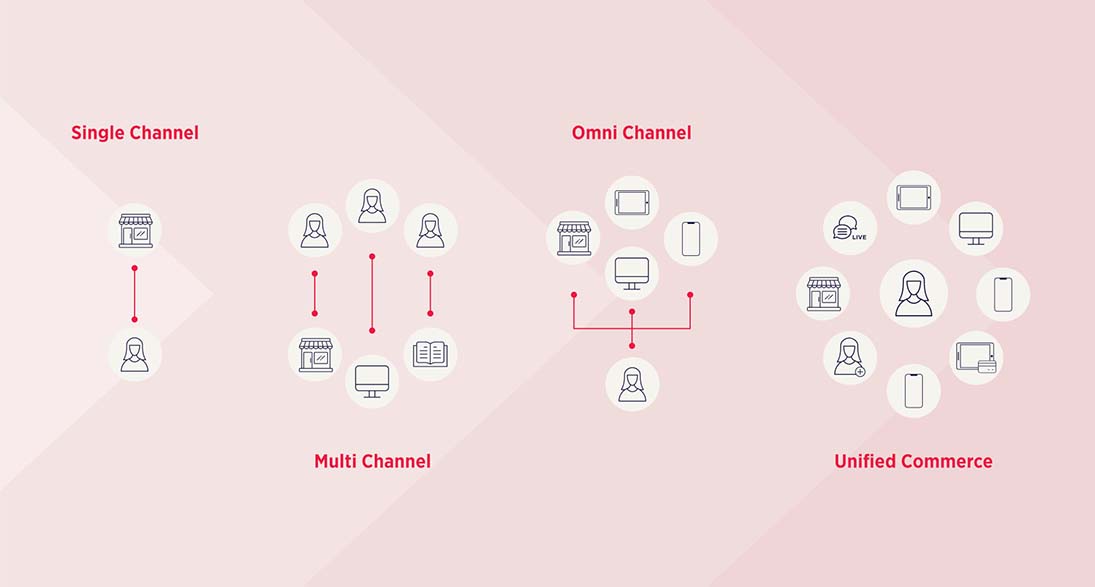THE FUTURE OF COMMERCE IS… UNIFIED!
Focus on customers and growth - by streamlining technology.

2023
Most retailers have, to this day, claimed Omnichannel success and Customer Centricity – but, sadly, this is partially true. Many have spoken about personalization, as well. “Backstage”, however, they still struggle to deliver essential Omnichannel experiences consistently and efficiently. Leaders, on the other hand, are creating the future with a Unified Commerce approach and are already seeing how it translates to profits through increased sales and operational efficiencies. But what is Unified Commerce?
To answer the question, let’s have a look at the past, to understand the present and create for the future.
Evolution of Commerce
In yesteryears, shopping meant an excursion – getting into a car and visiting a mall or store; a trip planned. This single-channel commerce dominated by brick-and-mortar retail, stood its ground for decades, until the rise of the digital era. In the past quarter-century, websites, marketplaces, advertising, social media, pop-up stores and phygital formats, mobile and smart devices, all of them became retail destinations, for most of which you do not have to leave the room or even plan ahead.
Retailers rushed to become multi-channel(ers) to expand their presence, making a patchwork-silo of various systems and applications they never knew before. Meanwhile, consumers were already getting comfortable leading their cross-channel lives and constantly hopping from one channel to another. While (s)hoppers initially sought convenience, they soon realized that they desired seamless experiences, which they were not getting.

This realization gave birth to a new strategy: Omnichannel. The solution was apparent—understand how multiple channels interact with each other and with the customer and then connect and personalize the shopping journey. This is the period where promises for integrated systems and big fat statements of “customer-centricity” were made. Intentions were sincere, but investment buy-in fell short; organizations could not fully comprehend that omni-channel is not a one-time investment, but a consistent, disciplined approach that involves both upgrading technology and updating retail processes. Because Omnichannel retail environments were composed of patchworks, as mentioned above, and due to the lack of investment and change mindset, Omnichannel Commerce became, for the most part, a tangled web of uncoupled channels and hastily integrated systems. This made it hard to deliver a consistent customer experience or to gain a cohesive understanding or view of a customer.
The changes these strategies brought, along with several external factors over the years such as macroeconomic conditions, demographic changes, and evolutions in consumer behavior, made the industry undergo major transformations and challenges.
Then came the pandemic and added fuel to the fire... it accelerated 5-year roadmaps to be delivered in less than a month! It’s a good thing, though, that even the remaining businesses, which hadn’t still embraced changes brought forward by the previous years, finally became aware of the stakes of reinvesting in the back-office ecosystem to afford to be flexible, sustain their services, brand image, and succeed in knowing their customers.
Enter Unified Commerce
Today brings us to the exact moment where the future is being crafted with Unified Commerce – a mature, dominant business strategy calling businesses to overhaul their tech architecture and operating model to keep pace with the changing landscape. With Unified Commerce, backend systems are leveraged in real-time, to build a continuous experience, no matter how or where the customer shops or continues their journey. Where previous investment emphasis was on digital services and front experience, there is now – TRUE – recognition that the debt of “keep systems running expenses” is crowding out investments in strategic priorities that would generate business value.
Unified Commerce recognizes that customers interact with a brand through various channels and devices, and it seeks to eliminate the disconnects and inconsistencies that hinder seamless experiences. It requires retailers to invest in integrated technology ecosystems that allow for real-time data sharing, inventory visibility, and unified customer profiles. Moreover, Unified Commerce focuses on leveraging data and analytics to gain actionable insights into customer behavior, preferences, and purchase history. This enables retailers to deliver personalized recommendations, targeted marketing campaigns, and tailored promotions. By understanding each customer's unique journey, retailers can anticipate their needs, foster stronger relationships, and drive customer loyalty.
In Unified Commerce there is ONE ORDER, ONE CUSTOMER, ONE CHANNEL and a Unified Platform.
 A Unified Commerce Platform serves as a critical tool in championing this strategy. It facilitates a centralized hub with the goal of forming a fully unified data model that leads to a single source of truth. In addition to improving the customer experience, a Unified Commerce Platform offers operational benefits as well. By centralizing data and streamlining processes, retailers can improve operational efficiency and reduce workarounds. This leads to cost savings, increased productivity, and better resource allocation. Moreover, a Unified Platform provides retailers with the agility and adaptability needed to meet changing market demands and emerging technologies. They can easily integrate new channels, adopt innovative solutions, and stay ahead of the competition.
A Unified Commerce Platform serves as a critical tool in championing this strategy. It facilitates a centralized hub with the goal of forming a fully unified data model that leads to a single source of truth. In addition to improving the customer experience, a Unified Commerce Platform offers operational benefits as well. By centralizing data and streamlining processes, retailers can improve operational efficiency and reduce workarounds. This leads to cost savings, increased productivity, and better resource allocation. Moreover, a Unified Platform provides retailers with the agility and adaptability needed to meet changing market demands and emerging technologies. They can easily integrate new channels, adopt innovative solutions, and stay ahead of the competition.
When you use a unified system, you may also limit integrations, as most of the functionality you need is already packaged in one platform.
The benefits of Unified Commerce
There are many advantages for businesses to embrace Unified Commerce, with the most important being:
1. Integrated Technology Ecosystem: Unified Commerce requires retailers to invest in an integrated technology ecosystem that connects various systems, channels, and touchpoints. By using a platform that natively offers or brings together different components of the retail infrastructure, such as point-of-sale (POS) systems, inventory management, customer relationship management (CRM), and order management, retailers can create a unified and interconnected environment. This integration enables data sharing, harmonizes technology, processes, and eliminates data silos.
2. Unified Customer Profiles: A key technical advantage of Unified Commerce is the ability to create unified customer profiles. By integrating data from various channels, retailers can consolidate customer information, purchase history, preferences, and interactions into a single, comprehensive profile.
3. Order Management, Inventory Visibility and Optimization: Unified Commerce facilitates efficient order management across all channels. It enables retailers to offer flexible fulfillment options such as ship-from-store, buy-online-pickup-in-store (BOPIS), and same-day delivery and fulfill orders from multiple inventory locations, including warehouses, stores, and distribution centers. By utilizing a centralized platform, retailers can efficiently manage orders, allocate inventory, and track shipments across channels, ensuring customer satisfaction and minimizing stockouts.
4. Data-Driven Insights and Analytics: Unified Commerce leverages data and Artificial Intelligence to gain actionable insights into customer behavior, preferences, and market trends. By analyzing data from multiple channels, retailers can identify current and future patterns, trends, and opportunities for growth. This data-driven approach enables retailers to make informed decisions, optimize pricing strategies, identify cross-selling and upselling opportunities, and deliver personalized experiences.
5. Scalability and Flexibility: Unified Commerce provides retailers with the scalability and flexibility to adapt to changing market conditions and consumer expectations. It allows retailers to easily add new channels, expand their online presence, and integrate emerging technologies. This adaptability ensures that retailers can stay ahead of the competition, embrace innovation, and deliver exceptional customer experiences.
Future is not about average results. Shoppers will continue to demand smooth and frictionless interactions when it comes to customer service, delivery, and returns. From the moment they discover a brand to the post-purchase support, they expect preferential treatment and a personalized, interactive experience at every touchpoint. Unified Commerce is not a buzzword; it's an awakening last call for businesses looking to succeed in the future of retail.
If you are going through the evaluation and selection process, the ideal Unified Platform will need to be rich in native functionality and agile enough to allow quick implementation of additional capabilities, as the organization scales or matures. Have you checked out A-commerce, ATCOM's Unified Commerce Platform?

